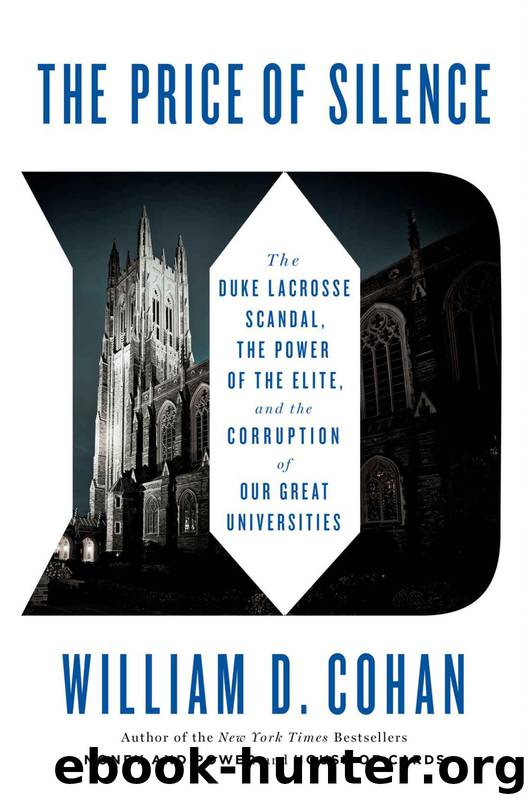The Price of Silence: The Duke Lacrosse Scandal by William D. Cohan

Author:William D. Cohan [Cohan, William D.]
Language: eng
Format: epub
Tags: Nonfiction, Retail, True Crime
ISBN: 9781451681796
Amazon: 1451681798
Barnesnoble: 1451681798
Publisher: Scribner
Published: 2014-04-08T04:00:00+00:00
CHAPTER ELEVEN
Nifong Loses Control of the Narrative
Not everyone at Duke applauded Brodhead’s decision to reinstate the lacrosse team. Orin Starn, a professor of cultural anthropology, told the Durham Herald-Sun he disagreed with the team’s return. “This is not to say there are not many good kids on the team,” he said. “But it’s a problematic pattern of conduct that really, to me, does not justify reinstatement next year, and calls for all the facts of the case to be known and for the court case to be resolved before we go forward and think about having lacrosse again at Duke.” He was not suggesting—as some on the Duke faculty had—that big-time athletics had no place at the school, but he was concerned about its growing emphasis. For the year ending October 2005, Duke athletics had generated $42 million in revenue, at a cost of around $40 million. Coach K’s basketball program generated revenue of more than $12 million, with profits of around $4.6 million; Duke football, meanwhile, with revenue of roughly $7.7 million, had a net loss of $1.6 million. “My own feeling is that college sports has grown into a very big commercial entertainment business with literally billions of dollars at stake, [with] TV contracts and coaching salaries and recruiting, and I think it’s wrong,” Starn continued.
The Chronicle’s editors were perplexed by Brodhead’s announcement. On the one hand, they wrote, reinstating the team was “both necessary and timely,” but the “parameters for the reinstatement” were “ambiguously worded” and “leave something to be desired.” The paper applauded Brodhead’s decision to reinstate the team and his timing: “Any earlier, it would not have been able to conduct a comprehensive investigation . . . any later, the program would have had to climb an even steeper slope in order to get back on its feet.”
Meanwhile, Nicholas Kristof, the heavyweight columnist at the New York Times, agreed with Brodhead that the alleged incident should be used for some “deep reflection,” not just about “racism and sexism” but also “about the perniciousness of any kind of prejudice that reduces people—yes, even white jocks—to racial caricatures.” Kristof noted in a June 11 column that the case had not been the “finest hour” for either academia or the news media. “Too many rushed to make the Duke case part of the three-hundred-year-old narrative of white men brutalizing black women,” he wrote. “The narrative is real, but any incident needs to be examined on its own merits rather than simply glimpsed through the prisms of race and class.”
He then walked through the “facts,” at least as they were then known after weeks of defense attorneys’ filings in Durham Superior Court and public briefings. According to Kristof, Nifong, not the lacrosse team, was the “real culprit.” He cited his belief that Nifong’s plethora of public statements in the opening weeks of the case “seem[ed] to violate the North Carolina rules of public conduct” and that Nifong had used the lacrosse case “as a campaign tool” in his successful three-way primary election, since he was “the lone white man on the ballot.
Download
This site does not store any files on its server. We only index and link to content provided by other sites. Please contact the content providers to delete copyright contents if any and email us, we'll remove relevant links or contents immediately.
The Borden Murders by Sarah Miller(3592)
The Secret Barrister by The Secret Barrister(3010)
Coroner's Journal by Louis Cataldie(2105)
Police Exams Prep 2018-2019 by Kaplan Test Prep(2038)
The Splendid and the Vile by Erik Larson(1790)
Terrorist Cop by Mordecai Dzikansky & ROBERT SLATER(1719)
My Dark Places by James Ellroy(1507)
A Colony in a Nation by Chris Hayes(1504)
Black Klansman by Ron Stallworth(1447)
A Life of Crime by Harry Ognall(1382)
Objection! by Nancy Grace(1333)
Whoever Fights Monsters by Robert K. Ressler(1324)
The New Jim Crow by Michelle Alexander(1317)
American Prison by Shane Bauer(1290)
Obsession (The Volkov Mafia Series Book 1) by S.E Foster(1280)
Anatomy of Injustice by Raymond Bonner(1269)
The Art of Flight by unknow(1265)
A Higher Loyalty by Comey James(1242)
A is for Arsenic: The Poisons of Agatha Christie (Bloomsbury Sigma) by Kathryn Harkup(1216)
